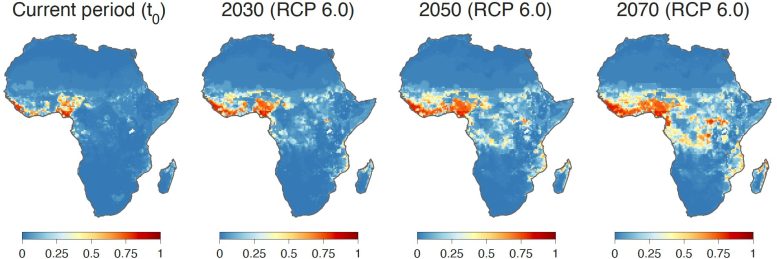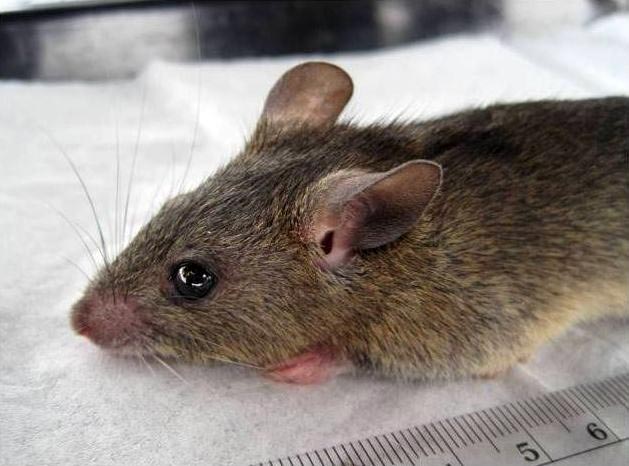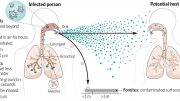
A study led by Scripps Research and the University of Brussels shows that the risk of exposure to Lassa virus, which can cause a severe and often lethal hemorrhagic fever disease, may expand substantially in the next several decades. Pictured are projections of the ecological niche suitability for Lassa virus based on climate models and other data. Credit: Scripps Research and University of Brussels
A new analysis finds that deadly Lassa fever could soon become a much bigger public health problem in Africa due to climate change and other factors. The study, by scientists at Scripps Research and the University of Brussels, will be published today (September 27) in the journal Nature Communications.
Scientists analyzed decades of environmental data associated with Lassa virus outbreaks, revealing temperature, rainfall, and the presence of pastureland areas as key factors contributing to viral transmission. In the next several decades, areas hospitable to Lassa virus spread may extend from West Africa into Central and East Africa, according to the researchers’ projections. With this expansion combined with expected African population growth, the human population living in the areas where the virus should—in theory—be able to circulate may rise by more than 600 million.
“Our analysis shows how climate, land use, and population changes in the next 50 years could dramatically increase the risk of Lassa fever in Africa,” says first author Raphaëlle Klitting, PhD. Now at Marseille University, he was a postdoctoral researcher at Scripps Research during the study.
Klitting was a member of the laboratory of study co-author and Scripps Research professor Kristian Andersen, PhD. The study’s senior author was Simon Dellicour, PhD, of the University of Brussels.
Lassa virus is a “zoonotic” virus that spreads from other animals to humans. In this case, the virus spreads from the Natal multimammate rat (Mastomys natalensis), most likely via its droppings. While an estimated 80% of infections are mild or asymptomatic, the remaining cases are more severe, with signs and symptoms that can include low blood pressure (shock), hemorrhaging from the mouth and gut, and potentially permanent hearing loss. The fatality rate for hospitalized patients is generally high, sometimes reaching 80%.

The Natal multimammate mouse (Mastomys natalensis), also known as the Natal multimammate rat, spreads the Lassa virus. Credit: Kelly, et al.
Several hundred thousand infections are estimated to occur each year, primarily in Nigeria and several other West African countries. There is no approved vaccine or highly effective drug treatment as of yet.
Although the primary animal reservoir for the Lassa virus is known, the virus spreads in only some—not all—areas where these animals are present. Therefore, it is possible that environmental factors also help determine whether and where significant viral transmission can occur. In the study, the scientists developed an ‘ecological niche’ model of Lassa virus transmission, using data on environmental conditions at sites of known spread.
Combining the model with projections of climate and land-use changes in Africa in the next several decades, as well as the known range of the Natal multimammate rat, the researchers estimated the areas of Africa that could support Lassa virus transmission currently, and in the years 2030, 2050, and 2070. The projected current areas corresponded well to known endemic areas in West Africa, but the estimates for future decades suggested a vast expansion within and beyond West Africa.
“We found that several regions will likely become ecologically suitable for virus spread in Central Africa, including in Cameroon and the Democratic Republic of the Congo, and even in East Africa, in Uganda,” Klitting said.
Currently, Africa’s population is undergoing rapid growth. Therefore, the researchers considered projections of this population growth for the areas of current and potential future Lassa virus circulation. They found that the number of people potentially exposed to the virus could increase from about 92 million today to 453 million by 2050, and 700 million by 2070—a more than 600% jump.
More hopefully, the scientists examined the dynamics of the spread of Lassa virus using data on sequenced viral genomes sampled at various locations in West Africa and found that virus dispersal appeared to be slow. They concluded that, unless transmission dynamics change drastically in the new location where the virus circulates, the virus’s spread into new ecologically suitable areas in the coming decades may also be slow.
According to the authors, the findings should inform African public health policies, for example, by encouraging officials to add Lassa virus to lists of viruses under epidemiologic surveillance in parts of Central and East Africa.
The study is also the result of an interdisciplinary approach involving molecular and evolutionary analyses as well as ecological and climate modeling.
“With the ongoing climate change and increasing impact of human activities on the environment, further comprehensive studies of the ecology and spread of zoonotic and vector-borne diseases are needed to anticipate possible future changes in their distribution as well as their impact on public health,” Dellicour says.
Reference: “Predicting the evolution of the Lassa virus endemic area and population at risk over the next decades” by Raphaëlle Klitting, Liana E. Kafetzopoulou, Wim Thiery, Gytis Dudas, Sophie Gryseels, Anjali Kotamarthi, Bram Vrancken, Karthik Gangavarapu, Mambu Momoh, John Demby Sandi, Augustine Goba, Foday Alhasan, Donald S. Grant, Sylvanus Okogbenin, Ephraim Ogbaini-Emovo, Robert F. Garry, Allison R. Smither, Mark Zeller, Matthias G. Pauthner, Michelle McGraw, Laura D. Hughes, Sophie Duraffour, Stephan Günther, Marc A. Suchard, Philippe Lemey, Kristian G. Andersen and Simon Dellicour, 27 September 2022, Nature Communications.
DOI: 10.1038/s41467-022-33112-3
The study was funded by the National Institutes of Health (U01AI151812, R01AI153044, U19AI135995), the European Union, the Wellcome Trust, the German Federal Ministry of Health, the Global Health Protection Program, the German Research Foundation, the Research Foundation – Flanders, and the Belgian Fonds National de la Recherche Scientifique.









And, we ‘may’ be hit by a large asteroid (or more likely, nuclear war). Until such time as modern day Nostradamus’ can assign probabilities to their predictions, they should be viewed as poorly supported speculations reserved for small talk at academic cocktail parties.